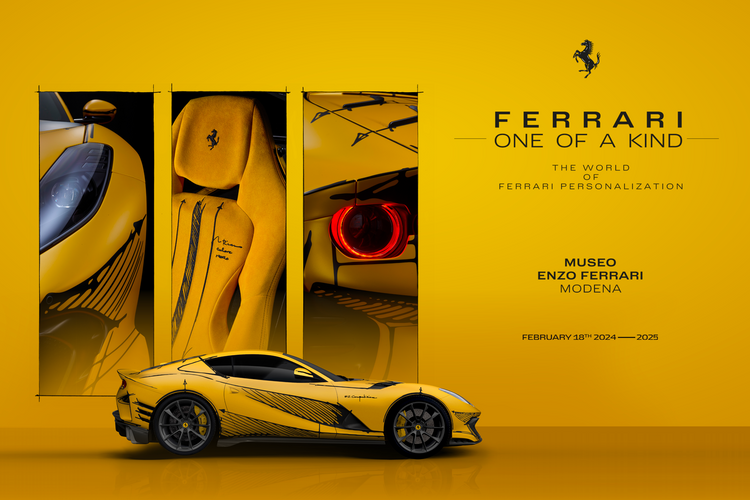
Copyright Enzo Ferrari Museum

Copyright Enzo Ferrari Museum
Introduction
In 2024, the Enzo Ferrari Museum offers an exceptional presentation, since instead of a simple temporary exhibition of a few models, it is renewing a large part of the cars exhibited in the main building with a focus on the “One of a Kind”, the unique models. I’m not going to tell here the Ferrari history, as the subject is widely documented in books, magazines and on the net. Let’s just remember that if the “Scuderia Ferrari” was born in 1929 to make Alfa Romeos race in the Grand Prix of the time. Then, after a few twists and turns, the first car to bear the name of Ferrari, the 125S appeared in 1947, already equipped with a V12 despite its small displacement of 1.5L.
In 1948, the first “road” model was presented with the 166 MM, which was closely derived from the 166 racing cars. As Enzo Ferrari was mainly interested in the engine and incidentally the chassis, and as there were many Italian coachbuilders (Ghia, Touring, Vignale, Pinin Farina etc.), the Ferraris produced were often unique, modified according to the wishes of the buyers.
Subsequently, Ferrari developed the production of (small) series of touring cars, with the sole aim of financing competition expenses. In the 1950s and 1960s, the 250 GT and then the 275 GT gave rise to a large line of cars, 2-seater or 2+2 coupés and convertibles. But at the same time, special models are also built for wealthy personalities, royal families, business leaders, sportsmen and show biz stars. Sometimes it’s simple modifications or special paints, but it’s also unique bodywork.

Although we have subsequently seen creations by coachbuilders on Ferrari bases, often show cars, “functional” models were rarely “homologated” by the Maranello brand. But more recently, and especially since Ferrari has its own design department, unique models have been developed directly by Ferrari.
My Favorites
No favorite this time, all the models are unique and are historical pieces that I chose not to choose from!
Enzo Ferrari Museum History
Remember that there are 2 Ferrari museums, the one in Maranello near the factory being more dedicated to competition and supercars.
In Modena, the museum is named after the founder of the brand and is instead dedicated to the history of Enzo Ferrari and the eponymous brand. It is built on the site of Enzo Ferrari's birthplace (1898), which was both his father's family home and workshop. It was also the initial headquarters of an Alfa Romeo dealership and Scuderia Ferrari, which was created in 1929 with the aim of entering Alfa Romeos in competition and helping private drivers prepare and maintain their Alfa Romeos. Enzo Ferrari sold the house a few years later and moved to Maranello.
The site and the surrounding land were bought in the 2000s with the aim of creating the museum. The Enzo Ferrari Museum, inaugurated in 2012, consists of 2 buildings, the original house and a modern building designed by architect Jan Kaplicky. The house-workshop has been restored and converted into an exhibition space while retaining some of its old character.
The modern building is a large arena which offers a 5000 sqm exhibition area on 2 levels, without pillars, allowing a plunging and unobstructed view of the entire exhibition. The building is covered by a dome that evokes the hood of a racing car from the 1950s. It also houses a restaurant, a large shop and a few additional showrooms on the ground floor.

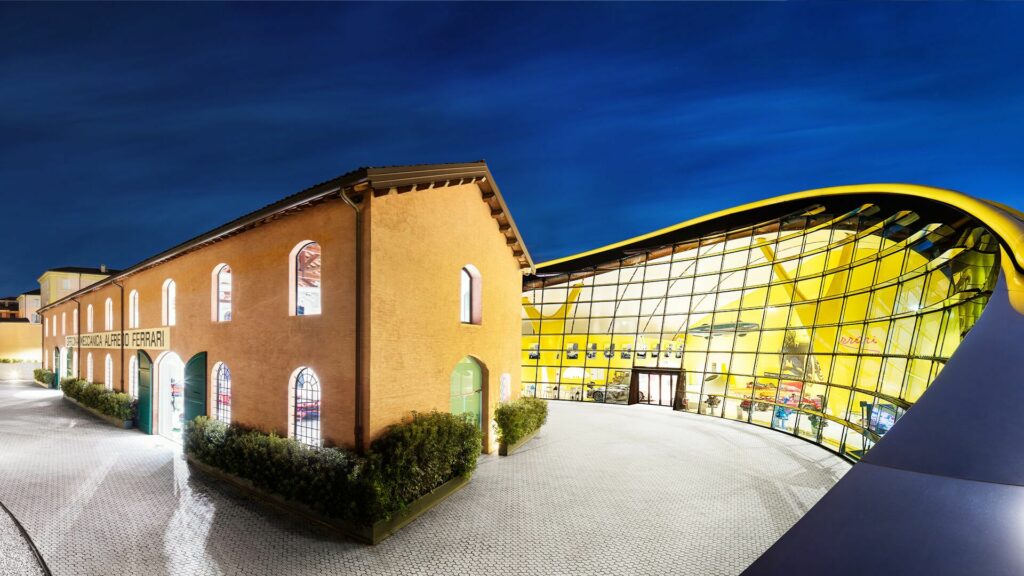
Copyright Enzo Ferrari Museum
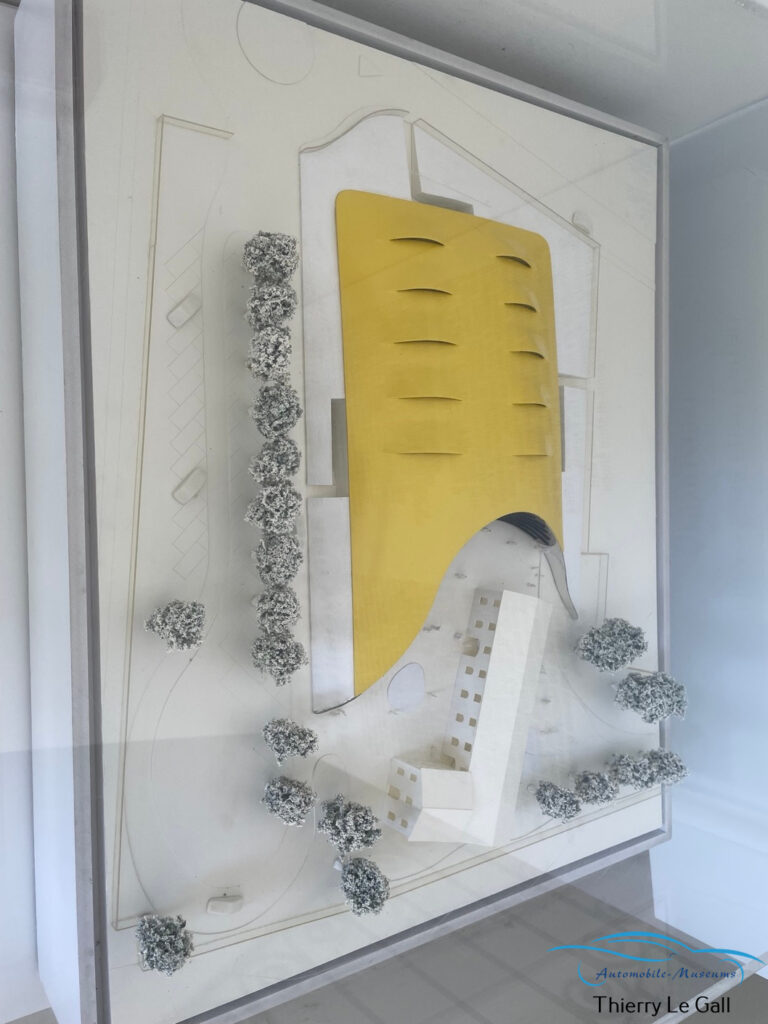
Copyright Automobile-Museums



Copyright Automobile-Museums
The Ferrari models lines
Although Ferrari produces its cars in small series, overall production has nevertheless grown in 25 years from less than 4,000 units to nearly 14,000 cars. And so the search for exclusivity has led to several layers in the range. Of course, there are the “catalogue” models, produced in (small) series, and which you can configure and order from your favorite dealership, such as the 296, Roma, 812 or Purosangue. Then comes the supercar family, initiated by the 288GTO, then the F40, F50, Enzo and the latest being the “LaFerrari Aperta”, a spider version of “La Ferrari”. They are launched at irregular intervals of several years, produced in limited series over a fairly short period of time.
The “Icona” are even more limited series (a few dozen or hundreds), which are reinterpretations of iconic Ferrari racing cars (hence their name) but using the most modern technologies. These are quite radical models, offered only to loyal Ferrari customers. Then there are the Special Editions, which are radical models and intended mainly, if not exclusively, for track driving. For the production models, the list of options is long, and Ferrari has defined several levels of customization, the most extreme being Tailor Made by which the customer can create a unique model with the help of a team of experts. For Icona models, extreme customization is the order of the day. This results in highly customized models that become unique configurations.
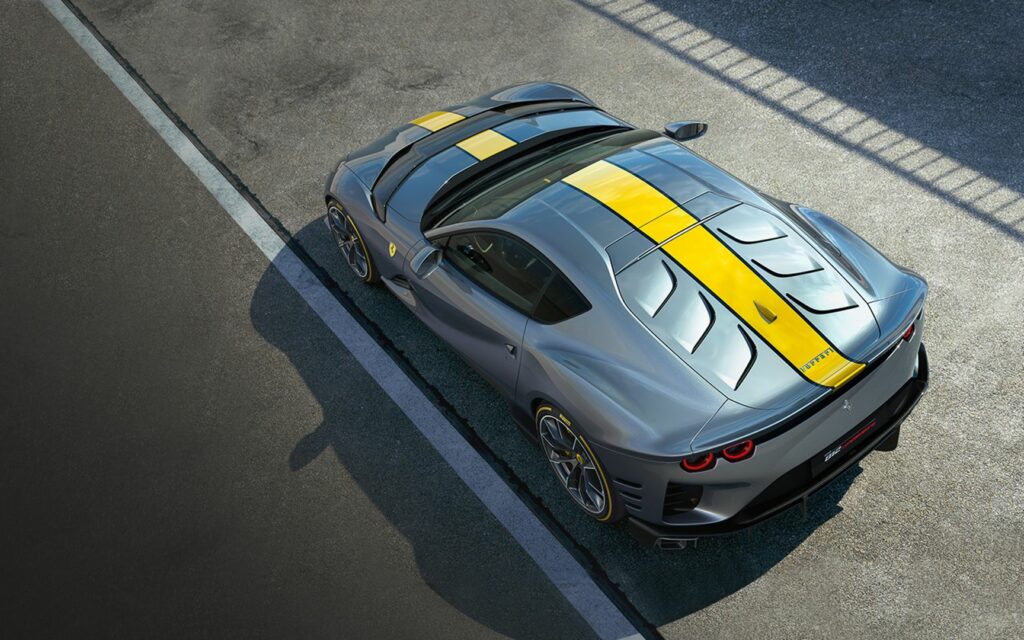
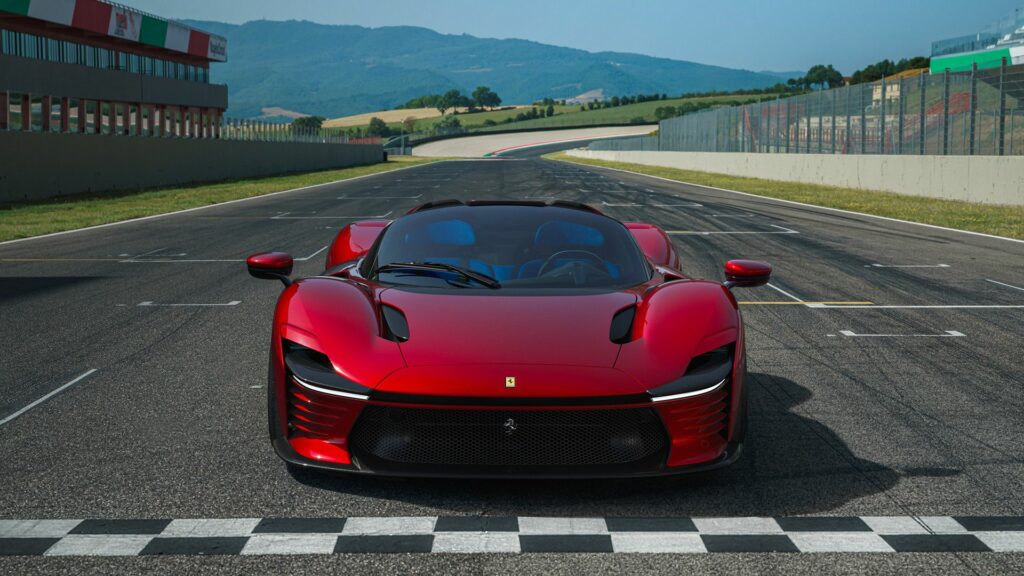
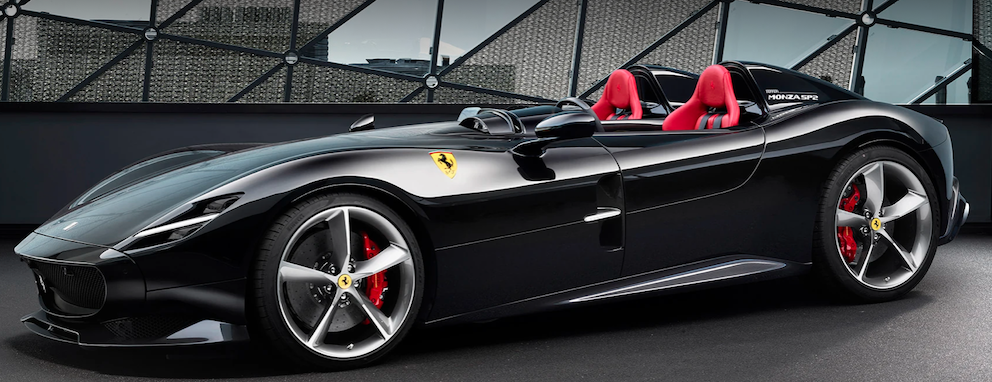
Copyright Ferrari SPA
But for passionate, loyal and (very) wealthy customers, the Prancing Horse can go even further by creating a truly unique car. In this case, it’s basically a matter of creating a model based on a client’s specifications. Starting from an existing model (engine and chassis, but which can be profoundly modified), Ferrari’s design department creates a unique design to dress up the technical base. It is often a question of evoking through modernized lines a mythical model of the brand, or one that is mythical for the customer. The interior is obviously designed according to the wishes of the client, who participates in all stages of the design and construction with Ferrari’s engineers and stylists. And this model will remain unique forever. But unlike a concept car or prototype, this is a fully functional car.
The “One of a Kind” exhibition
The One of a Kind exhibition is held in the large main building of the museum. An entire wall is dedicated to the customization capabilities offered by the brand, colors, materials, leathers, accessories… The first step towards exclusivity. On the largest wall, which becomes a giant screen, a film retracing the life of Enzo Ferrari is projected at regular intervals. And in the middle of this setting, you can admire these unique cars, some of which have never been presented to the public, or even to the press, except in photos. Suffice it to say that the term “unique and exceptional exhibition” is not overused.



Copyright Automobile-Museums
Copyright Enzo Ferrari Museum
On the other hand, the museum has planned to change the cars on display from time to time. It is understandable that a customer who has paid several hundred thousand, or even several million Euros or Dollars for his single car does not want to part with it for a whole year! Without going into the exhaustive presentation of the exhibition, here are some representative cars of the “One of a Kind” Ferraris, among the old, the Icona, the Tailor Made and the unique models.



Copyright Enzo Ferrari Museum
Ferrari 166 MM “Gianni Agnelli”: The 166, the 3rd Ferrari model presented in 1948, was available in several types of bodywork for competition and touring. Although the MM (for Mille Miglia) was more of a road car, it won the 1949 24 Hours of Le Mans. Built in 1948 and bodied by Carrozzeria Touring, the model presented is a splendid “Barchetta” whose every detail has been worked to reflect the taste of its owner, Gianni Agnelli (Boss of FIAT). The two-tone blue and green paint is a reminder of the family’s ties to the Italian royal house, Casa Savoia.


Copyright Enzo Ferrari Museum
Ferrari Monza SP1: built in 2018, this is the first example of the Icona “limited line”, inspired by the great Ferraris of the past. The Monza SP1 is a single-seater with no visible windscreen (the SP2 is its equivalent but in two-seater). Its classic styling is inspired by the “barquettas” of the 1950s but adding contemporary elements of high performance and high technology,. The model on display comes in an original gold livery, with the same colour on the wheels and interior trim, with a transverse stripe typical of some racing cars from the 1950s and 1960s.


Copyright Enzo Ferrari Museum
Ferrari Daytona SP3 Carbon Look: This second model in the Icona family pays homage to mid-engined sports prototypes such as the 330P3, 330P4 and 412P that won so many races in the 1960s. This example is unique in its coating of an extraordinary ruby red transitional carbon fiber with a natural finish, which offers exceptional chromatic reflections depending on the light.


Copyright Enzo Ferrari Museum
Ferrari 812 Competizione Tailor Made: The 812 Competitzione is a radical version of the 812 Superfast, with a V12 engine delivering 830 horsepower at 9500 rpm, an optimized chassis and very advanced aerodynamics. This model embodies the sleek approach taken by Ferrari’s design director, Flavio Manzoni. This One of a Kind Ferrari 812 Competizione Tailor Made is inspired by the blank sheet of paper used by designers to design a new Ferrari and displays the strokes of the designers’ pencils, transforming it into a contemporary work of art. The car on display is the first of the 812 Competizione special series limited to 999 units. It was auctioned off at a Ferrari charity gala in New York City on October 17, 2023.



Copyright Enzo Ferrari Museum
P80/C: This car, which Ferrari billed as the “most extreme special model ever designed” when presented, is inspired by the Dino 206S and 330 P3/P4 racing models. Exclusively intended for the track, it is based on the Ferrari 488 GT3 developed for GT3 racing. The creation of the Ferrari P80/C began in 2015 and it took Ferrari’s engineers three years of development to complete this project. This one-of-a-kind model is powered by a V8, but the Prancing Horse manufacturer has never revealed its true power.



Copyright Automobile-Museums
Motori
For Ferrari, the engine has always been at the heart of car design and development, and the brand is credited with producing some of the most capable engines in automotive history. If for a long time Ferrari engine meant V12 especially for purists, other architectures have emerged over time, in particular to meet the demands of competition or the market. Flat-12, V6, V8, V10, with or without Turbo, hybrids first in F1 and then on road versions.


Copyright Enzo Ferrari Museum
In the building of the house where Enzo was born, in what was originally the metal beams workshop, the Motori exhibition presents engines corresponding to different architectures, including the V8 and V12 among the most significant of the road models as well as F1 engines. Each time, next to several engines, a car illustrates its implementation and a chassis shows the layout of the engine.



Copyright Enzo Ferrari Museum
Another room on the ground floor of the main building displays other engines developed by Ferrari and the whole illustrates the variety of architectures and technologies used. A large panel shows the parts and interactions of the supercar “LaFerrari” hybrid powertrain and allows us to measure the complexity of this architecture, and to better understand its difficulty of development and optimization.



Copyright Automobile-Museums
The Archive Room
On the ground floor of the modern building, a room gives an idea of the Ferrari models archive. Large binders contain the references of each model built by the brand, and a plan on a table shows the contents. The Ferrari Classiche department can take care of the restoration and maintenance of vintage Ferraris. This department also relies on the archives for the authentication of models, the verification of chassis and engine numbers (the famous “matching numbers”), which brings a certain added value to a classic car.


Copyright Automobile-Museums
Other Areas
In the living wing of the house, there are a few pieces about history. For example, Enzo Ferrari’s office, a simple room with a desk, a meeting table, a few engravings and photos, or a lamp with a prancing horse at its foot, nothing ostentatious but where it is easy to imagine the presence of the Commendatore. Or a diorama of what the entrance to the establishment was like in the early 1930s.




Copyright Automobile-Museums
Conclusion
If you’re passing through Modena, and even if you’ve already visited the Enzo Ferrari Museum, be sure to go back to admire these unique cars. For some, it’s probably the first and last opportunity to see them “in real”.
The photos on this page belong to Automobile-Museums, the Enzo FerrariMuseums or Ferrari SPA, no right of reproduction without the express permission of the platform.
Museums are living places, and therefore the content or layout may have changed between the publication of this article and your visit. The layout may be different, cars may be absent (overhaul, maintenance, loan…) and new ones may have been joined the exhibition.
